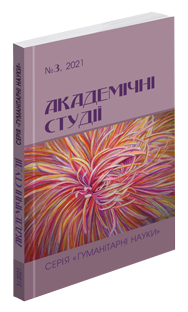Abstract
The problem of interrelation of semiotic signs, verbal units, and advertising specialists’ pragmatic intentions on the material of polycode texts of English modern social advertisements has been analyzed in the article. An advertisement is understood as a written text which is structurally, logically concluded and created intentionally. As known, social advertising, in contrast to a commercial one, touches upon essential matters and is made up for humanization of society. From a linguistic perspective, the advertisement is meant to be a nonhomogeneous structure. In other words, it combines verbal (lingual and communicative) and non-verbal (units which belong to different sign systems) elements. Taking into consideration complicatedness of the notion of a ‘polycode text’, it has been decided to combine Ch. S. Pierce’s classification of cognitive signs on different levels (semantic, syntactic, and pragmatic) and pragmatic and linguistic analysis methodology for examination of the chosen advertisement texts. As a result of data analyzing, it has been specified that each advertisement accumulates a set of signs (icons, indexes, and symbols) that indicates the problem to which the ad is dedicated in straightforward or indirect ways. It is revealing that within the chosen polycode texts the most important is a visual component (e.g., a preferred colour palette, graphic means, montage, collage, etc.) than a verbal one (a judgment or conclusion) that just recapitulates in brief a displayed social problem. Apparently, authors of advertising texts make use of various lexical-stylistic devices (on phonetic, lexical, and syntactical levels) to meet the goals. The signs and lexical-stylistic means complement each other harmoniously enhancing the efficiency of the advertising message.
References
Ейгер Г. В., Юхт В. Л. К построению типологии текстов. Лингвистика текста : материалы научной конференции при Московском государственном педагогическом институте иностранных языков им. М. Тореза : в 2 частях. Ч. 1. Москва, 1974. С. 46–62.
Зирка В. В. Современная реклама : манипуляция с модными словами. Лінгвістика XXI століття : збірник наукових праць. Серія «Нові дослідження і перспективи». Київ, 2010. С. 166–180.
Кохтев Н. Н. Стилистика рекламы : учебно-методическое пособие. Москва : Изд-во МГУ, 1991. 91 с.
Леонтьев А. А. Психолингвистические проблемы массовой коммуникации : монография. Москва : Наука, 1974. 147 с.
Лосева Л. М. Как строится текст : пособие для учителей. Москва : Просвещение, 1980. 94 с.
Медведева М. Е. Рекламная коммуникация. Москва, 2003. 160 с.
Тумакова Е. В. Креолизированный текст в художественном и медийном дискурсе. Мир русского слова. 2016. № 2. С. 43–49.
Пирс Ч. С. Элементы логики. Grammatica Speculativa: Семиотика : антология / сост. Ю. С. Степанов. Москва : Академический проект ; Екатеринбург : Деловая книга, 2001. С. 165–225.
Шикина Д. С. О терминах «поликодовость» и «креолизация» в описании рекламного текста глянцевых журналов. Вестник Московского государственного областного университета. 2018. № 2. С. 351–363.

